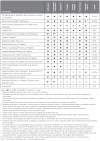How Timid or Bold Are Ministries of Health and Provincial Health Authorities in Canada in Planning for Healthcare Quality?
- PMID: 37695710
- PMCID: PMC10519334
- DOI: 10.12927/hcpol.2023.27154
How Timid or Bold Are Ministries of Health and Provincial Health Authorities in Canada in Planning for Healthcare Quality?
Abstract
Introduction: World Health Organization (WHO) guidelines recommend countries set quality plans for their health systems with clear priorities, indicators and targets. This paper examines whether Canada's federal, provincial and territorial governments are applying these principles.
Methods: We evaluated plans from 2010 to 2019 for 14 ministries of health and four health authorities in provinces with a single authority against a rubric that considered the existence of indicators, baselines, targets, time frames and progress reports.
Results: Ratings ranged from A+ to F with a median B/B-. Most jurisdictions had indicators, but only five of 18 jurisdictions had clear baselines, numeric targets and time frames. Irregularities were observed, such as vague indicators; setting goals to "improve" without targets; announcing targets only after plans had ended; setting minimal targets; removing targets after missing them previously; or inappropriate characterization of progress.
Discussion: Most Canadian governments are reluctant to set quality targets. We speculate there may be fear of criticism if targets are missed. However, several jurisdictions had clear, ambitious plans that may serve as examples for others.
Introduction :: Les lignes directrices de l'Organisation mondiale de la Santé (OMS) recommandent aux pays d'établir, pour leurs systèmes de santé, une planification de la qualité des soins qui comprend des priorités, des indicateurs et des objectifs clairs. Le présent document évalue dans quelle mesure les gouvernements fédéral, provinciaux et territoriaux du Canada appliquent ces principes.
Méthode :: Nous avons évalué les plans, entre 2010 et 2019, de 14 ministères de la Santé, et quatre autorités sanitaires dans les provinces ayant une seule autorité, en fonction d'une grille qui tenait compte des indicateurs, des données de référence, des objectifs, des échéanciers et des rapports d'étape.
Résultats :: Les cotes allaient de A+ à F avec un B/B- médian. Il y avait des indicateurs dans la plupart des administrations, mais seulement cinq des 18 administrations étudiées s'étaient dotées de bases de référence, d'objectifs numériques et d'échéanciers clairs. Des irrégularités ont été observées, comme des indicateurs vagues, l'établissement d'objectifs d'« amélioration » sans cibles, l'annonce de cibles seulement après la fin des plans, l'établissement de cibles minimales, l'élimination de cibles après les avoir ratées ou la caractérisation inappropriée des progrès.
Discussion :: La plupart des gouvernements canadiens hésitent à fixer des objectifs pour la qualité. Nous supposons qu'il pourrait y avoir une crainte des critiques si les objectifs ne sont pas atteints. Cependant, plusieurs administrations se sont dotées de plans clairs et ambitieux qui pourraient servir d'exemples pour les autres.
Copyright © 2023 Longwoods Publishing.
Similar articles
-
Canada's Shared Health Priorities: Measuring Progress and Bridging Data Gaps With Common Indicators.Healthc Q. 2025 Jan;27(4):11-13. doi: 10.12927/hcq.2025.27590. Healthc Q. 2025. PMID: 40406832
-
Was priority setting included in the Canadian COVID-19 pandemic planning and preparedness? A comparative analysis of COVID-19 pandemic plans from eight provinces and three territories.Health Policy. 2023 Jul;133:104817. doi: 10.1016/j.healthpol.2023.104817. Epub 2023 Apr 5. Health Policy. 2023. PMID: 37150048 Free PMC article.
-
A summary of the Pan-Canadian framework on sexually-transmitted and blood-borne infections.Can Commun Dis Rep. 2018 Jul 5;44(7-8):179-181. doi: 10.14745/ccdr.v44i78a05. eCollection 2018 Jul 5. Can Commun Dis Rep. 2018. PMID: 31011299 Free PMC article.
-
Canadian Contraception Consensus (Part 1 of 4).J Obstet Gynaecol Can. 2015 Oct;37(10):936-42. doi: 10.1016/s1701-2163(16)30033-0. J Obstet Gynaecol Can. 2015. PMID: 26606712 English, French.
-
The Canadian Alcohol Policy Evaluation project: Findings from a review of provincial and territorial alcohol policies.Drug Alcohol Rev. 2021 Sep;40(6):937-945. doi: 10.1111/dar.13251. Epub 2021 Feb 4. Drug Alcohol Rev. 2021. PMID: 33543532 Review.
Cited by
-
Reversing the Stigma around Canada's Poor-Performing Healthcare Systems.Healthc Policy. 2023 Aug;19(1):8-22. doi: 10.12927/hcpol.2023.27162. Healthc Policy. 2023. PMID: 37695702 Free PMC article.
References
-
- Alberta Health Services (AHS). 2017. The 2017–2020 Health Plan and Business Plan. Retrieved July 26, 2023. <https://www.thebsf.ca/media/files/upload/3g.%20Alberta%20Health%20Servic...>.
-
- Alberta Health Services (AHS). 2018. The 2017–2020 Health Plan and Business Plan: Year 2 of 3-Year Plan 2018/2019. Retrieved July 26, 2023. <https://www.albertahealthservices.ca/assets/about/org/ahs-org-hpbp-2017-...>.
-
- Alberta Health Services (AHS). 2019. The 2017–2020 Health Plan and Business Plan: Year 3 of 3-Year Plan 2019–2020. Retrieved July 26, 2023. <https://www.albertahealthservices.ca/assets/about/org/ahs-org-hpbp-2017-...>.
-
- Berwick D.M., Calkins D.R., McCannon C.J., Hackbarth A.D. 2006. The 100,000 Lives Campaign: Setting a Goal and a Deadline for Improving Health Care Quality. JAMA 295(3): 324–27. doi:10.1001/jama.295.3.324. - PubMed
-
- Bozeman B., Kingsley G. 1998. Risk Culture in Public and Private Organizations. Public Administration Review 58(2): 109–18. doi:10.2307/976358.
MeSH terms
LinkOut - more resources
Full Text Sources


